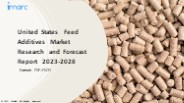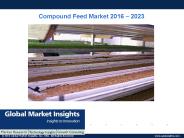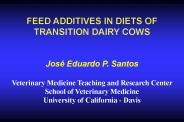Feed Acidifiers PowerPoint PPT Presentations
All Time
Recommended
Feed Acidifiers Market - Global Growth Drivers & Opportunities
| PowerPoint PPT presentation | free to download
Download free PDF Sample@ https://bit.ly/30lIywy #ChemicalsAndMaterials #Chemicals #MarketAnalysis This report covers market size and forecasts of Feed Acidifiers, including the following market information: Global Feed Acidifiers Market Size, 2019-2021, and 2020 (quarterly data), (US$ Million) & (K MT) Global Feed Acidifiers Market Size by Type and by Application, 2019-2021, and 2020 (quarterly data), (US$ Million) & (K MT) Global Feed Acidifiers Market Size by Region (and Key Countries), 2019-2021, and 2020 (quarterly data), (US$ Million) & (K MT)
| PowerPoint PPT presentation | free to download
The global feed acidifiers market size grew from $2.48 billion in 2022 to $2.71 billion in 2023 at a compound annual growth rate (CAGR) of 9.0%.
| PowerPoint PPT presentation | free to download
The cattle feed & feed additives market size is expected to see strong growth in the next few years. It will grow to $80. 96 billion in 2028 at a compound annual growth rate (CAGR) of 5.9%.
| PowerPoint PPT presentation | free to download
Feed Acidifiers market is segmented by region (country), players, by Type, and by Application. Players, stakeholders, and other.
| PowerPoint PPT presentation | free to download
The feed acidifiers market is estimated to be valued at USD 2.73 billion in 2018 and is projected to reach USD 3.50 billion by 2023, at a CAGR of 5.1% during the forecast period. The market is driven by the growing government aids or funds in the feed industry and high threat of diseases among livestock.
| PowerPoint PPT presentation | free to download
Feed acidifiers market will grow at a rate of 5.45% for the forecast period of 2021 to 2028. The increasing consumption of meat and dairy products is a vital factor driving the growth of feed acidifiers market.
| PowerPoint PPT presentation | free to download
Download Free Research Report PDF : https://bit.ly/2BOLB6J Blend Feed Acidifiers market is segmented by Type, and by Application. Players, stakeholders, and other participants in the global Blend Feed Acidifiers market will be able to gain the upper hand as they use the report as a powerful resource. Free Research Report PDF: https://bit.ly/2BOLB6J
| PowerPoint PPT presentation | free to download
The Business Research Company offers cattle feed and feed additives market research report 2023 with industry size, share, segments and market growth
| PowerPoint PPT presentation | free to download
Feed acidifiers market will grow at a rate of 5.45% for the forecast period of 2021 to 2028. The increasing consumption of meat and dairy products is a vital factor driving the growth of feed acidifiers market.
| PowerPoint PPT presentation | free to download
The feed acidifiers market is projected to reach USD 3.50 billion by 2023, at a CAGR of 5.1% during the forecast period. Covid-19 impact on Feed Acidifiers Market get report today. Increasing government aid promoting the growth of the feed industry and the high threat of diseases in livestock are factors driving this market.
| PowerPoint PPT presentation | free to download
The report on Global Feed Acidifiers Industry 2015 Market Research Report added by DecisionDatabases.com gives an in depth industry analysis of the market. It covers the costing, sales, revenue details and forecasts.
| PowerPoint PPT presentation | free to download
Animal Feed And Feed Additives Market Foreseen to Grow Exponentially by 2026
| PowerPoint PPT presentation | free to download
[168 Pages Report] Feed Acidifiers Market report categorizes the Global market by Type (Propionic Acid, Fumaric Acid, Lactic Acid, Formic Acid), By Livestock (Swine, Cattle, Poultry, Aquatic Animals) & by Geography
| PowerPoint PPT presentation | free to download
Animal feed plays an essential role in the food chain because feed is the most crucial contributor in ensuring safe, abundant and affordable animal protein. The never-ending growth in global population and increase in consumer’s income has demanded for healthy animal protein around the world. The poultry feed industry is a part of animal husbandry. The demand for animal protein has propelled the need for growth of poultry globally. The poultry feed market is characterized by leading trends such as non-traditional poultry feed ingredients, genetically modifies feed and technological innovation within the industry.
| PowerPoint PPT presentation | free to download
Animal Feed And Feed Additives Market Set for Rapid Growth and Trend, by 2026
| PowerPoint PPT presentation | free to download
The growth in Asia-Pacific region is supported by several internal factors which includes industrialization and supply chain integration of dairy sector and limited pasture lands as well as external factors such as import restrictions on inferior quality meat.
| PowerPoint PPT presentation | free to download
Animal Feed Additive Market deals with the production and distribution of animal feed additives of various types to the global feed additives market. Feed additives are the edible supplements for farms animals that are unable to get sufficient nutrition from their regular food.
| PowerPoint PPT presentation | free to download
Feed Additives Market by Type (Amino Acids, Vitamins, Carotenoids, Enzymes, Prebiotics and Probiotics, Minerals, Acidifiers, Lipids, and Others) and Livestock (Poultry, Ruminants, Swine, Aquaculture, and Others): Global Market Size Estimates and Forecast (2022-2030)
| PowerPoint PPT presentation | free to download
Feed Additives Market https://www.htfmarketintelligence.com/report/global-feed-additives-market
| PowerPoint PPT presentation | free to download
Swine (Pig) Feed Additives Market categorizes the global market by Type (Starter, Grower, Sow), Additive (Antibiotics, Vitamins, Antioxidants, Amino Acids, Feed Enzymes, Feed Acidifiers) and by Geography
| PowerPoint PPT presentation | free to download
Feed Additives Pages 319 325 (Chapter 6)
| PowerPoint PPT presentation | free to view
www.lexington.sg/poultry-products.php - Manufacturers, Suppliers & Exporters of Poultry Feed Additives from Singapore. Our poultry products are Nutritionals, Probiotics, Electrolytes, Toxin Binders, Immunity Enhancers, Liver Stimulants, Enzymes, Nutrient Enhancers, Growth Promoters, Acidifiers, etc.
| PowerPoint PPT presentation | free to download
www.lexington.sg/poultry-products.php - Chicken Feed Additives Manufacturers, Suppliers & Exporters from Singapore. Our poultry products are Nutritionals, Probiotics, Electrolytes, Toxin Binders, Immunity Enhancers, Liver Stimulants, Enzymes, Nutrient Enhancers, Growth Promoters, Acidifiers, etc.
| PowerPoint PPT presentation | free to download
Poultry Feed Market Analysis by Top Players, Size, Share and Forecast to 2027
| PowerPoint PPT presentation | free to download
Feed additive are the functional ingredients added to the feed to aid healthy growth of animals. There are various types of feed additives catering to a host of nutritional requirements depending upon livestock. The major types of feed additives include amino acids, acidifiers, enzymes, vitamins, minerals, and texturants among others. In the recent past, the demand for feed has witnessed growth due to growing awareness of farmers, decreasing quality of natural feed and rising nutrient deficiency disorders in animals.
| PowerPoint PPT presentation | free to download
[268 Pages Report] Poultry Feed Additives Market categorizes the Global market by Type (Layers, Broilers, And Turkeys), Additives (Antibiotics, Vitamins, Antioxidants, Amino Acids, Feed Enzymes, And Feed Acidifiers) & by Geography
| PowerPoint PPT presentation | free to download
Feed additive are the functional ingredients added to the feed to aid healthy growth of animals. There are various types of feed additives catering to a host of nutritional requirements depending upon livestock. The major types of feed additives include amino acids, acidifiers, enzymes, vitamins, minerals, and texturants among others.
| PowerPoint PPT presentation | free to download
[232 Pages Report] Fish Feeds Market Report categorizes the Market by End Consumption (Fish Feeds, Tilapia, Carp, Salmon), by Additives (Antioxidants, Antibiotics, Vitamins, Amino Acids, Feed Enzymes and Feed Acidifiers), & by Geography Forecasting 2018.
| PowerPoint PPT presentation | free to download
Animal Feed Additives Market Size Report | Forecast & Growth by 2028
| PowerPoint PPT presentation | free to download
[268 Pages Report] Poultry Feed Market categorizes the Global market by Type (Layers, Broilers, And Turkeys), Additives (Antibiotics, Vitamins, Antioxidants, Amino Acids, Feed Enzymes, And Feed Acidifiers) & by Geography
| PowerPoint PPT presentation | free to download
[232 Pages Report] Global Fish Feeds Market Report categorizes the Market by End Consumption (Fish Feeds, Tilapia, Carp, Salmon), by Additives (Antioxidants, Antibiotics, Vitamins, Amino Acids, Feed Enzymes and Feed Acidifiers), & by Geography Forecasting 2018.
| PowerPoint PPT presentation | free to download
Feed additive are the functional ingredients added to the feed to aid healthy growth of animals. There are various types of feed additives catering to a host of nutritional requirements depending upon livestock. The major types of feed additives include amino acids, acidifiers, enzymes, vitamins, minerals, and texturants among others. In the recent past, the demand for feed has witnessed growth due to growing awareness of farmers, decreasing quality of natural feed and rising nutrient deficiency disorders in animals. The increasing industrialization of meat production in emerging economies such as China, India, and Vietnam is providing impetus to the market growth.
| PowerPoint PPT presentation | free to download
According to Precision Business Insights, the Feed Additives Market to grow at a CAGR of 5.7% by forecast 2029. It is segmented by Type, livestock, Form & Source
| PowerPoint PPT presentation | free to download
According to the latest research report by IMARC Group, The United States feed additives market size reached US$ 4.1 Billion in 2023. Looking forward, IMARC Group expects the market to reach US$ 5.3 Billion by 2032, exhibiting a growth rate (CAGR) of 2.8% during 2024-2032. More Info:- https://www.imarcgroup.com/united-states-feed-additives-market
| PowerPoint PPT presentation | free to download
Global Animal Feed Additives Market Size 2017 by Type [Antioxidants, Antibiotics, Amino acids (Tryptophan, Lysine, Methionine, Threonine, and Others), Vitamins (A, E, B, C, and Others), Feed enzymes (Non-Starch Polysaccharides, Phytase), Feed Acidifiers and Others], by Livestock (Poultry, Cattle, Pork/Swine, Aquaculture, and Others), By Region and Forecast 2018 to 2025
| PowerPoint PPT presentation | free to download
Anfotal Nutritions is manufacturer of animal feed suppplement and feed additives for all poultry birds, fishes/ prawns and shrimps and all other livestock. We provide best nutrition product, Manufacturer Layer Premix India for animals and all supplements and additives are pure and we uses fresh items to make these supplements
| PowerPoint PPT presentation | free to download
Global Animal Feed Additives Market, By Product Type (Antibiotics, Vitamins, Antioxidants, Amino Acids, Enzymes, Acidifiers), Livestock (Pork/Swine, Poultry, Cattle, Aquaculture), and Geography - Insights, Size, Share, Opportunity Analysis, and Industry Forecast till 2025
| PowerPoint PPT presentation | free to download
Probiotics. Living bacteria or yeast cultures to enhance microbial balance ... Similar results to probiotics. Enzymes. Increase nutrient utilization ...
| PowerPoint PPT presentation | free to view
Animal feed additives are chemicals used to improve the quality of feed products to enhance the performance and health of animals.
| PowerPoint PPT presentation | free to download
Feed additives are used in animal nutrition to enhance the quality, properties of animal feed in order to boost features such as overall gut health/digestive performance, palatability preservation and others. Feed additives have gained importance globally, on account of improving the overall health of animal and quality and quantity of meat produced from them. For example, in poultry diets, feed additives are used to improve the birds laying capacity, feed utilization and disease prevention. Similarly, swine diet includes various natural and synthetic additives such as, acidifiers, high dietary levels of copper and zinc, phytase to boost the performance and profitability of swine feed. Check complete report @ http://www.marketintelreports.com/report/allied0106/world-animal-feed-additives--market-opportunities-and-forecast-2014--2021
| PowerPoint PPT presentation | free to download
According to the latest research report by IMARC Group, The South Korea animal feed market size is projected to exhibit a growth rate (CAGR) of 2.52% during 2024-2032. More Info:- https://www.imarcgroup.com/south-korea-animal-feed-market
| PowerPoint PPT presentation | free to download
Vitamins product segment surpassed USD 425 million in 2020 and is estimated to record a CAGR of above 5% in the forecast period.
| PowerPoint PPT presentation | free to download
Feed additive are the functional ingredients added to the feed to aid healthy growth of animals. There are various types of feed additives catering to a host of nutritional requirements depending upon livestock. The major types of feed additives include amino acids, acidifiers, enzymes, vitamins, minerals, and texturants among others. In the recent past, the demand for feed has witnessed growth due to growing awareness of farmers, decreasing quality of natural feed and rising nutrient deficiency disorders in animals. The increasing industrialization of meat production in emerging economies such as China, India, and Vietnam is providing impetus to the market growth.
| PowerPoint PPT presentation | free to download
According to the latest research report by IMARC Group, The Europe swine feed market size reached US$ 34.5 Billion in 2023. Looking forward, IMARC Group expects the market to reach US$ 47.0 Billion by 2032, exhibiting a growth rate (CAGR) of 3.4% during 2024-2032. More Info:- https://www.imarcgroup.com/europe-swine-feed-market
| PowerPoint PPT presentation | free to download
According to the latest research report by IMARC Group, The global poultry feed market size reached US$ 210.4 Billion in 2023. Looking forward, IMARC Group expects the market to reach US$ 289.0 Billion by 2032, exhibiting a growth rate (CAGR) of 3.5% during 2024-2032. More Info:- https://www.imarcgroup.com/poultry-feed-market
| PowerPoint PPT presentation | free to download
The global feed additives market size is expected to grow from $18.28 billion in 2022 to $19.88 billion in 2023 at a compound annual growth rate (CAGR) of 8.7%.
| PowerPoint PPT presentation | free to download
Animal Feed Acidifier Market – Industry Trends and Forecast to 2028 Animal Feed Acidifier Market – Industry Trends and Forecast to 2028
| PowerPoint PPT presentation | free to download
TBRC global swine feed minerals market report includes starter feed or grower feed, sow feed, pig grower feed, other products, cereal, oilseed meal, oil, molasses, other ingredients https://bit.ly/3YdCKAX
| PowerPoint PPT presentation | free to download
According to the latest research report by IMARC Group, The Indonesia animal feed market size reached US$ 7.9 Billion in 2022. Looking forward, IMARC Group expects the market to reach US$ 10.6 Billion by 2028, exhibiting a growth rate (CAGR) of 4.8% during 2023-2028. More Info:- https://www.imarcgroup.com/indonesia-animal-feed-market
| PowerPoint PPT presentation | free to download
According to the latest research report by IMARC Group, The United States feed additives market size reached US$ 4.0 Billion in 2022. Looking forward, IMARC Group expects the market to reach US$ 4.8 Billion by 2028, exhibiting a growth rate (CAGR) of 3.2% during 2023-2028. More Info:- https://www.imarcgroup.com/united-states-feed-additives-market
| PowerPoint PPT presentation | free to download
The growing levels of commercial livestock production are among the primary factors driving the US animal feed market. Additionally, the widespread product adoption as a source of energy and nutrition to support muscular activity and sustain life processes in the animals is further catalyzing the market growth. Besides this, the increasing consumer awareness towards the various health benefits of algae-based ingredients in animal feed is acting as another significant growth-inducing factor.
| PowerPoint PPT presentation | free to download
Compound Feed Market Size, Industry Analysis Report, Regional Outlook, Application Development Potential, Price Trends, Competitive Landscape & Forecast, 2016 – 2023
| PowerPoint PPT presentation | free to download
Animal feed acidifier market is expected to grow at a CAGR of 4.90% in the forecast period 2021 to 2028. Increasing consumption of meat and dairy products is the major factor driving the growth of animal feed acidifier market in the forecast period of 2021-2028.
| PowerPoint PPT presentation | free to download
FEED ADDITIVES IN DIETS OF TRANSITION DAIRY COWS Jos Eduardo P. Santos Veterinary Medicine Teaching and Research Center School of Veterinary Medicine
| PowerPoint PPT presentation | free to download
The growth of the Global Compound feed market is majorly driven by factors such as the growth in global meat consumption, increase in awareness towards meat quality and safety, increase in mass production of meat, and recent livestock disease outbreaks. Globally increasing population is also supporting growth of the world meat market, ultimately increasing demand for compound feed. Increase in consumer awareness regarding benefits of organic food and meat led to increase in consumption which in turn led to increase in demand for organic feed. Different regulatory structures, volatile economies, and increasing cost of operations are the major restraining factors for the market. And, an increase in the cost of raw materials is also a key challenge for the companies in the market.
| PowerPoint PPT presentation | free to download
























































